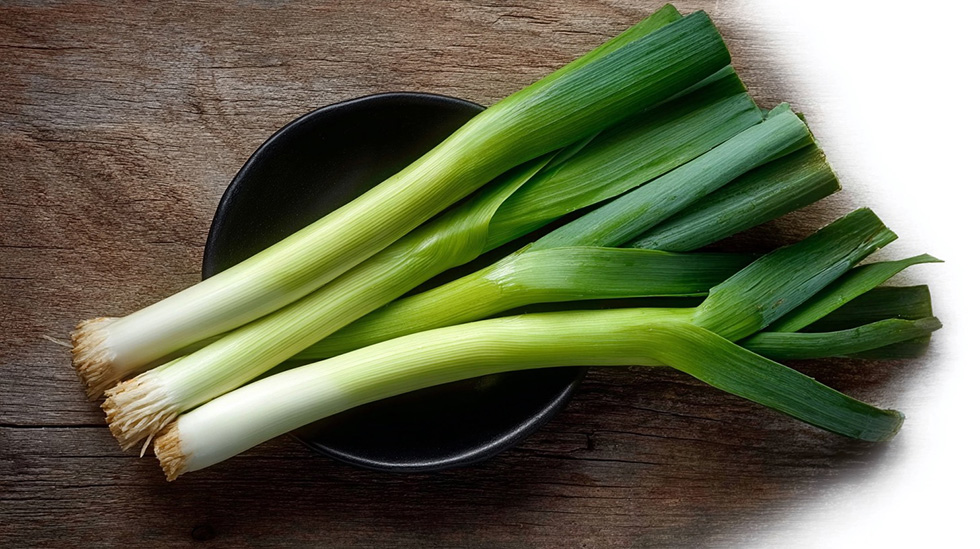On what tree does the leek grow?
Leeks, or leeks as they are known scientifically Allium ampeloprasum var. porrum , belongs to the onion family. An ancient plant, it was eaten in ancient Egypt – so much so that it was even found in the tombs of the Pharaohs! It has been a stalwart in our kitchens ever since, and is a favourite vegetable in Europe in particular, not only because of its taste, but also because it is versatile, healthy and beautiful. Yes, because let’s face it: a fresh leek looks elegant. 😊

How important is it in the kitchen?
Importance: 4 / 5
Leeks are not as common as red onions or garlic, but once you get hooked, you can’t put them down. It’s a real secret trump card: its flavour is milder and softer than most onions, and it blends beautifully into soups, casseroles, quiches and even grilled!
Which part is edible?
The leek is elongated, with an elongated white stalk and the light green part is edible. The white part is tender, slightly sweet and the most popular. The light green part is also edible, mainly cooked or fried. The dark green leaves are tougher and fibrous and are used more for base juice and cooking. They are difficult to digest raw. There are no poisonous parts, but it is better to leave the root remains and the dark green, too old leaves out of the cooking.
Why does your body love it?
Leeks are a true soul food: they are rich in vitamin K, vitamin A and C, as well as folic acid, iron, manganese and antioxidants. It supports the immune system, aids digestion and has anti-inflammatory properties. The allicin compound it contains may also help lower blood pressure and cholesterol levels. It’s also low in calories, so it’s ideal for dieters. 💪
How does it grow and where does it come from?
Leeks are grown outdoors, but in colder climates they are also grown under a greenhouse. The main season is autumn to spring – especially from September to March. In Europe, France, Belgium and the Netherlands are the biggest producers, but there are also plenty in England and Spain. It’s also grown in Hungary, and you can get home-grown specimens mainly in the autumn. In summer you are more likely to get imported produce, mainly from Spain or the Netherlands.
How to choose leeks in the shop?
Not as tricky as you think! Watch these:
- It should be firm and crispy to the touch – avoid the soft, slimy ones!
- The leaves should be bright green, not yellowish or with brownish edges.
- The stems should be snow-white, intact and free from too much soil.
- The longer the white stem, the better! (This is the tastiest part.)
Storage tips – how long will it stay fresh?
Store the leeks in the fridge, wrapped in a plastic bag or paper towel to prevent them from drying out. This will keep them fresh for up to 1 week. Once washed, drain well as moisture will ruin it sooner. You can also freeze it: slice it into rings, blanch it briefly and then put it in a box in the freezer.
Leeks around the world
A favourite staple vegetable of the French: the star of the iconic “vichyssoise” cold cream soup. English cuisine loves to fry it with cheese, Spaniards use it as a base for tortillas, while Italians put it in risotto or vegetable stews. It is also used in Middle Eastern dishes, especially in stews and casseroles – where it also fits in well with the spicy character.
Best-known recipe: vichyssoise
This is a cold soup of French origin, but popular in America, made with leeks, potatoes, butter, cream and stock. The leeks are sautéed in butter, the potatoes are added, the stock is poured over them, and when cooked through, they are blended and cooled. A really elegant summer dish!
Tips for use in the kitchen
Leeks are mainly used cooked or stewed – raw they can be a little too intense, although sliced very thinly they can be added to salads. It goes well with:
- for butter, cream
- for cheeses, especially goat cheese or feta
- for potatoes, carrots, celery
- spices: thyme, nutmeg, white pepper, parsley
What you should avoid: strong, dominant spices such as curry or cloves, as they can overpower the soft character of the leeks.
Cue
Leeks are an undeservedly overlooked culinary treasure. If you’ve never tried it, it’s time to take it off the shelf and add it to your kitchen repertoire! It’s healthy, delicious and surprisingly versatile – so give it a chance and your soup will thank you! 🧅💚
